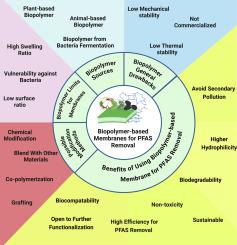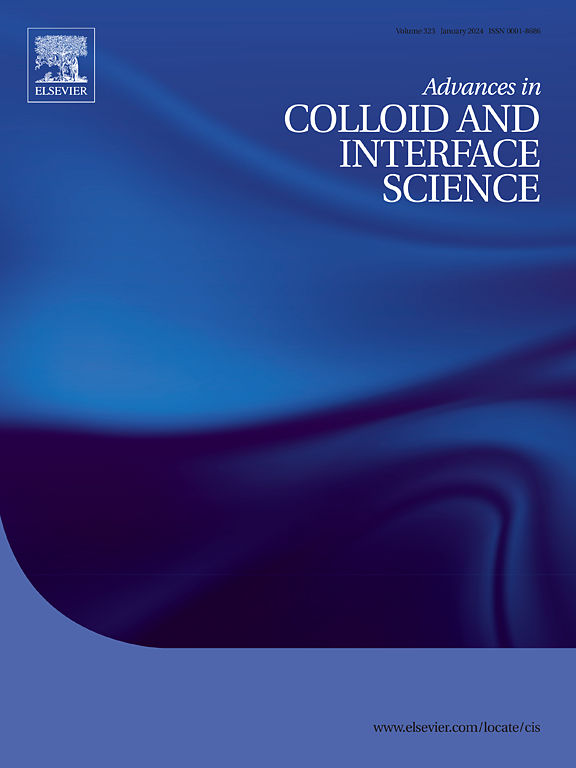Biopolymer-based membranes and their application in per- and polyfluorinated substances removal: Perspective review
IF 19.3
1区 化学
Q1 CHEMISTRY, PHYSICAL
引用次数: 0
Abstract
Over the past 2 decades, per- and polyfluoroalkyl substances (PFAS) have attracted considerable attention due to their widespread occurrence and adverse effects on both the environment and human health. PFAS possess strong carbon‑fluorine bonds that confer exceptional chemical stability and resistance to natural degradation; their fluorinated chains are highly hydrophobic and oleophobic, while their polar functional groups contribute to amphiphilic behavior and water solubility. Certain PFAS thus pose serious risks to living organisms, especially mammals. Membrane filtration is recognized as a particularly effective technique, achieving removal efficiencies greater than 99 % for long-chain-PFAS (including anionic, cationic, and zwitterionic PFAS molecules). However, many conventional membrane processes rely on petroleum-based polymers and non-biodegradable materials which lead to significant sustainability concerns. The disposal of these materials harms the environment and contributes to secondary pollution. In this review, biopolymers are presented as alternatives and their different sources are categorized and discussed in detail. Further, the latest applications of commercial membranes for PFAS removal are discussed and compared with those of biopolymer-based membranes (BBMs). Finally, recommendations for advancing PFAS removal using BBMs are provided, and current knowledge gaps are highlighted. This manuscript therefore underscores the importance of evolving membrane technology within a circular economy framework.

生物聚合物基膜及其在全氟和多氟物质去除中的应用:展望综述。
在过去二十年中,全氟烷基和多氟烷基物质因其广泛存在和对环境和人类健康的不利影响而引起了相当大的关注。PFAS具有很强的碳氟键,具有优异的化学稳定性和抗自然降解能力;它们的氟化链是高度疏水和疏油的,而它们的极性官能团有助于两亲性和水溶性。因此,某些PFAS对生物体,特别是哺乳动物构成严重风险。膜过滤被认为是一种特别有效的技术,对长链PFAS(包括阴离子、阳离子和两性离子PFAS分子)的去除效率超过99%。然而,许多传统的膜工艺依赖于石油基聚合物和不可生物降解的材料,这导致了重大的可持续性问题。这些材料的处理危害环境,造成二次污染。在这篇综述中,介绍了生物聚合物作为替代品,并对它们的不同来源进行了分类和详细讨论。此外,还讨论了工业膜在去除PFAS方面的最新应用,并与生物聚合物基膜(BBMs)进行了比较。最后,提出了使用bbm推进PFAS去除的建议,并强调了当前的知识差距。因此,本文强调了在循环经济框架内发展膜技术的重要性。
本文章由计算机程序翻译,如有差异,请以英文原文为准。
求助全文
约1分钟内获得全文
求助全文
来源期刊
CiteScore
28.50
自引率
2.60%
发文量
175
审稿时长
31 days
期刊介绍:
"Advances in Colloid and Interface Science" is an international journal that focuses on experimental and theoretical developments in interfacial and colloidal phenomena. The journal covers a wide range of disciplines including biology, chemistry, physics, and technology.
The journal accepts review articles on any topic within the scope of colloid and interface science. These articles should provide an in-depth analysis of the subject matter, offering a critical review of the current state of the field. The author's informed opinion on the topic should also be included. The manuscript should compare and contrast ideas found in the reviewed literature and address the limitations of these ideas.
Typically, the articles published in this journal are written by recognized experts in the field.

 求助内容:
求助内容: 应助结果提醒方式:
应助结果提醒方式:


